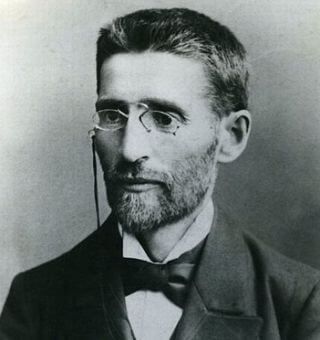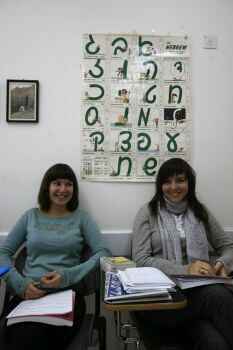The story of the resurrection of Hebrew goes back thousands of years. Millennia ago, the Jewish people spoke ancient Hebrew to one another, engaged in commerce speaking Hebrew, and worshiped in Hebrew – all in the land of Israel.
The Bible, too, was written in Hebrew.
For over 3,000 years, the Jewish people have read from hand-written Torah scrolls in synagogues and learned from printed editions in study halls and in their homes – all in Hebrew. The Mishna, which records the Jewish Oral Tradition, the prayers, and most rabbinic literature are in Hebrew. There are also examples of Hebrew used in literature throughout Jewish history, with a specific renaissance in the 19th century.
But upon being exiled from the land of Israel 2,000 years ago, Hebrew ceased to be the spoken language of the Jewish people. Even the small numbers of Jews who remained in Israel began speaking the language of their conquerors and lost Hebrew.
Join the fight for Israel’s fair coverage in the news
And now Hebrew has been resurrected – spoken throughout the land of Israel and even among Jews in other places in the world.
There is no other story in world history of an ancient language revived to become a spoken language by any faith, country or nation.
The Resurrection of Hebrew: How Did it Happen?
The process began during the first half of the 19th century as Jews began returning to the land of Israel, reconnecting with the small Jewish community that had remained there throughout the exile and Jews who had returned in previous generations. To enable a common language among the various Jewish groups in Israel who spoke Yiddish, Ladino, or Arabic, they began to speak Hebrew.
Around the same time, the dream of a return to Israel among European Jews led to a drive to resurrect Hebrew – especially in Zionistic educational programs and in meetings related to the Zionist movement.
Related reading: The Jewish Connection to the Land of Israel
Key in the establishment of any community is schooling. In their attempts to resurrect a sovereign Jewish state in the Land of Israel, the early Zionists realized the importance of setting up schools in which a common language was taught. The first Hebrew boarding school where Jewish studies were taught in Hebrew and in which teachers and students communicated in Hebrew was established in 1884 by Aryeh Leib Frumkin.
The Haviv school became the first Hebrew elementary school of modern times when it was established in 1886 in Rishon LeZion. Gradually, all schools in the agricultural settlements began teaching their general studies in Hebrew. Attempts to transform Hebrew into the only language spoken in the settlements and cities failed because parents saw Hebrew as an impractical language lacking the words to describe day-to-day activities. Yes, people knew ancient Hebrew because of their familiarity with the Bible but that didn’t help them with their need to communicate in a modern world.
The Man Behind Hebrew’s Revival: Eliezer Ben-Yehuda

Enter Eliezer Ben-Yehuda, the historical figure credited with the resurrection of Hebrew as a spoken language.
As Jewish nationalism rose in 19th century Europe, Ben-Yehuda and others believed that for the nation to be worthy of national rights, it had to speak in a common, national language. He is credited with being the first to begin conversing in Hebrew, deciding in 1881 that he would speak to family and friends in Hebrew alone, first in Paris and then in Jerusalem where he moved late that year.
Ben-Yehuda’s first child, Itamar Ben-Avi, was born on July 31, 1882 and was raised to be a Hebrew speaker – the first native speaker of Modern Hebrew. In an attempt to convince other families to play their part in Hebrew’s resurrection, he published a Hebrew newspaper called “HaZvi” and founded associations for Hebrew speaking. This effort was met with great frustration as very few families agreed to the exclusive use of Hebrew.
Unfazed, Ben-Yehuda founded the Clear Language Society in 1889 with the goal of teaching Hebrew throughout Israel. And in 1890, he established the Hebrew Language Committee which addressed the need for new Hebrew words for modern-day conversation. The committee published books, dictionaries, bulletins, and periodicals, inventing thousands of new words, project to ancient sources and roots to create modern Hebrew words.
For example, chashmal meaning electricity, is derived from Ezekiel (1:4) 1 where chashmal is the word used to describe a color in the middle of a fire. The same was done for modern foods which didn’t exist in the Torah such as tapuz for orange and glida for ice cream. Since an orange resembles a “golden orange,” tapuz is a combination of tapuach which is the ancient Hebrew word for “apple,” and zahav which is the ancient Hebrew word for “gold.” The Mishna uses the word galid to refer to a frozen substance that can be used for a spiritual bath. Onkelos, who wrote a translation/commentary to the Torah used the word “glida” for the Torah’s word kerach,”meaning “ice.” (Genesis 31:9)
In 1903, the Union of Hebrew Teachers was established. The founding group included just 60 teachers, but the Union led to hundreds of Hebrew speakers who demonstrated that Hebrew could be used in a day-to-day conversational context.
Completing the Resurrection: Hebrew’s New Reality

As the Second Aliyah began in the beginning of the 20th century, the use of Hebrew in Israel became widespread as the language of communication. Most of these new immigrants were familiar with the Hebrew literature of 19th century Europe and believed that Hebrew was necessary for the development of an official national home for the Jewish people in Israel.
The Hebrew Language Committee was reestablished with a mission “to prepare the Hebrew language for use as spoken language in all affairs of life,” and focused on forming uniform rules of grammar. Hebrew-only schools gradually became the norm and once graduates of the early Hebrew schools began creating families of their own, Hebrew quickly became the popular language of conversation both in homes and the streets.
The final step in the resurrection of Hebrew and its establishment as an official language of the developing state came in 1913 when a proposal to use German as the official language of the Technion engineering school — filled with its extensive technological vocabulary — was overturned amid anger by the students, faculty and the broader community.
All of the above created a reality on the ground in Israel which served as the basis for the British decision to establish three official languages in Palestine when they took control of the region following World War I – Arabic, English, and…Hebrew!
Related reading: The Hebrew Language and the State of Israel
When Israel declared its independence in 1948, despite the high percentage of the population made of immigrants, over 80 percent of Jews in Israel reported that Hebrew was the only language which they used in their daily conversations.
Despite the deep connection which Israel’s founding generation had with Hebrew, they made sure to establish Arabic as an official language of the new state alongside Hebrew to make sure that the minority population in the Jewish state felt welcome as equal citizens.
And now this ancient, biblical language has been resurrected and in the streets of Israel today you can hear a people speaking the same language as King David in the very same land over 2,500 years ago.
Liked this article? Follow HonestReporting on Twitter, Facebook, Instagram and TikTok to see even more posts and videos debunking news bias and smears, as well as other content explaining what’s really going on in Israel and the region.
Featured image: CC BY-NC-ND antefixus21 with additions by SeekClipArt;


